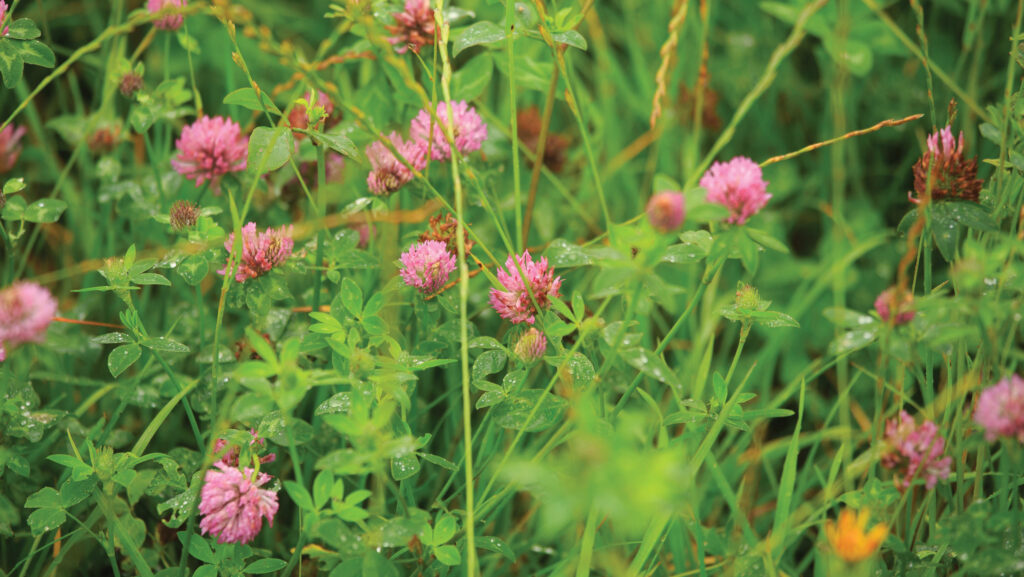How to get the most from red clover in silage
 © Tim Scrivener
© Tim Scrivener Red clover silage leys respond well in a multicut system, with best results from mowing every five weeks.
Cutting at the red bud stage just before flowering in mid-May will also balance optimum crop yield with crude protein levels, says Rhun Fychan, forage research scientist at the Institute of Biological, Environmental and Rural Sciences at Aberystwyth University.
“Multicut systems suit legumes more than a conventional three-cut.
“A high-yielding first cut can shade out clover, and a first cut from a mixed sward will contain more grass than subsequent cuts, as clover comes into life later,” he says.
“You need frequent cuts to maintain clover content, and in later cuts, where there is more stem, it is harder to compact clover in the clamp – it’s easier to compact leaf.”
Although Rhun says red clover is a good material to work with, turning it into great silage needs the same meticulous approach as a conventional ryegrass sward, to minimise losses.
Even in a good silage, losses are typically 25% between field and feeding out, he says.
“For small areas of red clover, consider bales for flexibility and feeding to specific stock – there is also more efficient fermentation in bales,” he adds.
Cutting and wilting
For clamped material, cutting red clover to a 7-10cm stubble and using a spreader mower to get a rapid wilt helps preserve the protein and energy, he says.
Wilting to 30% dry matter also reduces the risk of leaf loss and concentrates sugars, which are “the fuel” for fermentation.
“Take care with clover as it has fragile leaves, and the leaf is high [nutritional] quality.
“Machines designed for legumes are gentle on the crop. Use a spreader mower so you don’t need to ted it.
“A rubber roller-conditioner designed for legumes crushes the stem and leaves the leaf intact.
“Rake at low revs, and preferably when there is dew on the crop, to keep the leaf intact.”
Clovers have half the sugar content of a perennial ryegrass – white clover is 8.4%, red 7.6%, and ryegrass contains 14.3% – but Rhun says this should not be a concern as lucerne has half the sugar of clover yet ensiles successfully.
However, ensiling and compacting thin layers to expel air and achieve a high forage density at the clamp is critical because of the low sugars.
Doing this will ensure anaerobic fermentation. “Have maximum tractor weight throughout filling – not just at the end,” he stresses.
Exclude air, reduce losses
Sealing the silo using side sheets and adding weight to exclude air will also help reduce losses.
“Clamps should be more like bales – fully sealed,” he says. “A badly sealed clamp lets carbon dioxide out and oxygen in, and this results in dry matter losses.
Carbon dioxide is heavy and collects at the base, so hold it in with sausages [silage clamp bags].”
To get a rapid drop in pH for good fermentation, Rhun says an inoculant of Lactobacillus plantarum is as effective in a clover sward as for a pure grass crop.
“You need one million bacteria for 1g of grass for our humid, moist UK conditions.”
An additional feature of red clover (but not white clover) is that leaves turn brown during wilting and at ensilage.
This is caused by polyphenol oxidase, the same chemical that causes an apple to turn brown when cut.
It reduces protein breakdown in the clover, leaving more available for the animal.
Feed out silage using a sharp shear grab and move rapidly across the face to reduce spoilage.
Clover facts
- Red clover/ryegrass swards can produce 10-14t/ha of dry matter a year
- Red clover silage averages 14-19% crude protein
Source: AHDB
Rhun Fuchan was speaking at AHDB Dairy’s recent Curious about Clover meeting in Cheshire
